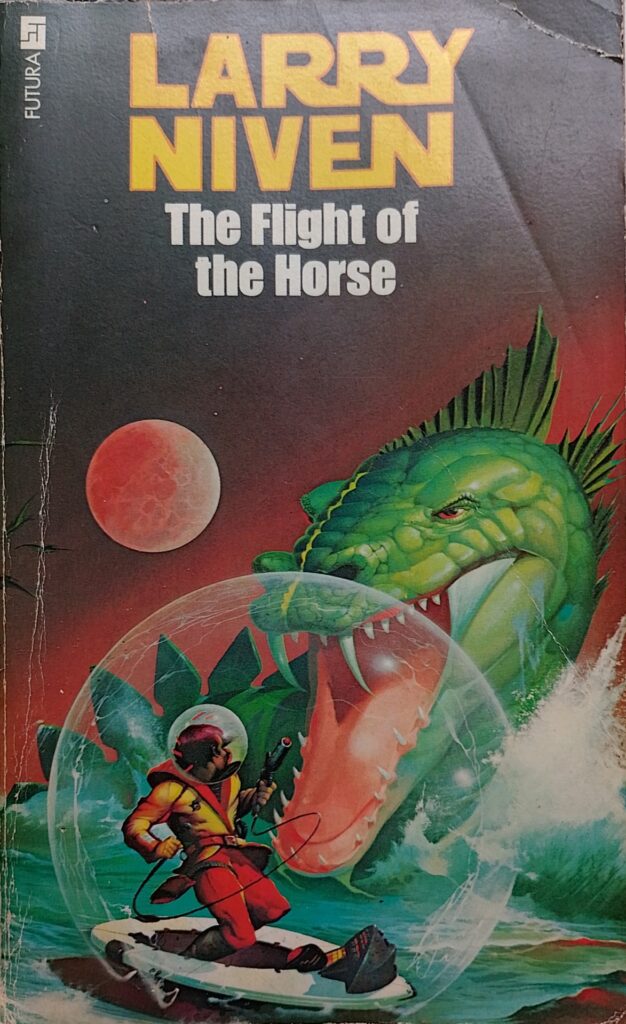First published 1974. Futura paperback, 1979, pp 212, c.65,000 words.
Niven is best known these days for his Ringworld books, but he was also a prolific short-story writer in Science Fiction’s golden age. This is a collection of seven stories first published in magazines from 1969 to 1972. All the first five feature Svetz as the protagonist and build on each other. The last two stories are unrelated in character or setting, but do have some similarity of theme. They are relatively long, varying between fourteen and sixty-five pages.
Svetz is a character rather like Pirx from Stanislaw Lem’s books. He is the pilot of some kind of space travel device, and full of doubt about his own skill and enthusiasm for the tasks he agrees to undertake. There is something similarly amusing about his bumbling tone. However, Svetz’s space-craft is different from Pirx’s in that it is a time machine rather than a spacecraft. Niven is only too aware of the logical absurdity of time machines and considered them mere fantasy devices. Here he takes that idea and runs with it, each story winding up a notch on the previous adventure in time travel.
The background to these stories is familiar to readers of SF of the period: in the future, humanity has made a mess of Earth and is living with the consequences. The environment is a wasteland, but cleverly he has allowed humans to evolve so that they can breath the noxious air, but that means that if they travel back to the past, they cannot breath the mix of gasses then present in the air. There are some clever touches with the spacesuits giving Svetz something of the appearance of an angel. One of the problems with using short-stories on the same theme previously published elsewhere is the repetition of the set-up. A bit of editing might have removed that bump.
The sixth story, Flash Crowd, explores the consequences of instant teleportation across the planet. It is a highly imaginative view of the dystopian consequences of such a development. Niven isn’t concerned with the technicalities of such as device, but with the impact it might have on society, for good and ill. There is also some clever working out of the consequences of the device on the physical world – the need to conserve momentum – and how those consequences might be mitigated by the use of what is here termed ‘velocity dampers.’ The story really concerns the social consequences; the ease with which a crowd of like-minded people can form and disperse, and the related impact of fast-news. These themes seem only too relevant today, even without teleportation devices. The protagonist is Jerryberry, a roving reporter or ‘newstaper’. He has something of the same character as Svetz: although an instigator of action, he is more an observer and someone intent on mitigating the consequences of the actions that he sets in motion.
The last story, What Good is Glass Dagger?, has the appearance of a more conventional fantasy story, where magic is an everyday reality. Again Niven is less concerned with the workings of magic, but the consequences. The story is set in the distant past (12,000 years B.C., according to the opening sentence), but it is somewhere like medieval Earth with pre-historic elements. To a degree it is a story about how the world we know came to be, how gods and magic died out. It is also a story about standing on our own feet and dealing with the real world.
Part of the fun of reading these old stories is spotting the anachronisms as well as the predictions that come close to home. In Flash Crowd we have Penny’s department stores, which do still exist despite a recent brush with bankruptcy, and also TWA and Eastern which no longer exist as airlines, although United does. Characters smoke a lot as was common in the seventies. Of a list of things that have been cured by the time of Flash Crowd, the only one that isn’t still a problem is ‘slow-mail’ [p138]. Sadly we are still living with smog in some places. Traffic jams and slum landlords remain with us.
As usual with stories written at this time, there are no women in important roles. At least I didn’t spot any expected to serve in the kitchen.
All the stories are fluently written, highly imaginative and amusing. While not especially deep, there are elements in each that are thought provoking. And the cover of this edition is actually a rather accurate depiction of one of the stories; a surprise when most SF books of the period have completely unrelated covers.
Wikipedia biography of Niven: https://en.wikipedia.org/wiki/Larry_Niven
Wikipedia summary of the book: https://en.wikipedia.org/wiki/The_Flight_of_the_Horse
Others’ reviews of the book: https://www.goodreads.com/book/show/378683.The_Flight_of_the_Horse?from_search=true&from_srp=true&qid=aZW3zEJrXb&rank=1
© William John Graham, September 2023

